Please help! My azaleas are sick and dying
kate5000
17 years ago
Related Stories

LIFE10 Feel-Better Things to Do on a Sick Day at Home
Nourish, pamper and heal yourself when a cold keeps you housebound, with these restorative ideas
Full Story
HOUSEKEEPINGWhen You Need Real Housekeeping Help
Which is scarier, Lifetime's 'Devious Maids' show or that area behind the toilet? If the toilet wins, you'll need these tips
Full Story
DECLUTTERINGDownsizing Help: How to Edit Your Belongings
Learn what to take and what to toss if you're moving to a smaller home
Full Story
PETS6 Ways to Help Your Dog and Landscape Play Nicely Together
Keep your prized plantings intact and your dog happy too, with this wisdom from an expert gardener and dog guardian
Full Story
FEEL-GOOD HOMESimple Pleasures: The Joy of Fresh Sheets
Make your bed a place of comfort and relaxation with good-quality linens, ample pillows and other pleasing accoutrements
Full Story
EARTH DAYGrow a Beautiful Garden With Ecofriendly Greywater
Reducing home water waste means lower bills and a healthier planet. Here's how to set up a greywater home irrigation system that can help
Full Story
EARTH DAYHow to Design a Garden for Native Bees
Create a garden that not only looks beautiful but also nurtures native bees — and helps other wildlife in the process
Full Story
LIFE10 Ways to Honor and Remember a Departed Loved One at Home
Help the grieving process and keep beautiful memories alive with these thoughtful tributes
Full Story
DECLUTTERINGEscape the Inheritance Trap: What to Do With Sentimental Pieces
Too meaningful to toss but too hideous, precious or unusual to display? These ideas can help
Full Story
EDIBLE GARDENSNatural Ways to Get Rid of Weeds in Your Garden
Use these techniques to help prevent the spread of weeds and to learn about your soil
Full Story





morz8 - Washington Coast
kate5000Original Author
Related Professionals
Clark Landscape Architects & Landscape Designers · Piqua Landscape Architects & Landscape Designers · River Forest Landscape Architects & Landscape Designers · Mount Wilson Landscape Architects & Landscape Designers · Broomfield Landscape Contractors · Canby Landscape Contractors · Cerritos Landscape Contractors · Fort Worth Landscape Contractors · Lehigh Acres Landscape Contractors · Roseville Landscape Contractors · Roswell Landscape Contractors · Stallings Landscape Contractors · Vancouver Landscape Contractors · Wailuku Landscape Contractors · Wentzville Landscape Contractorsrhodyman